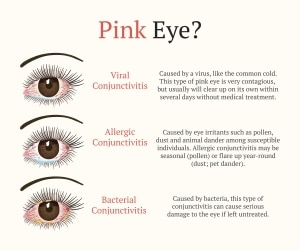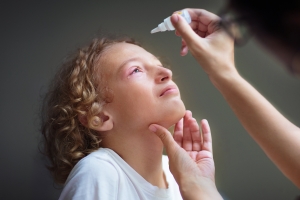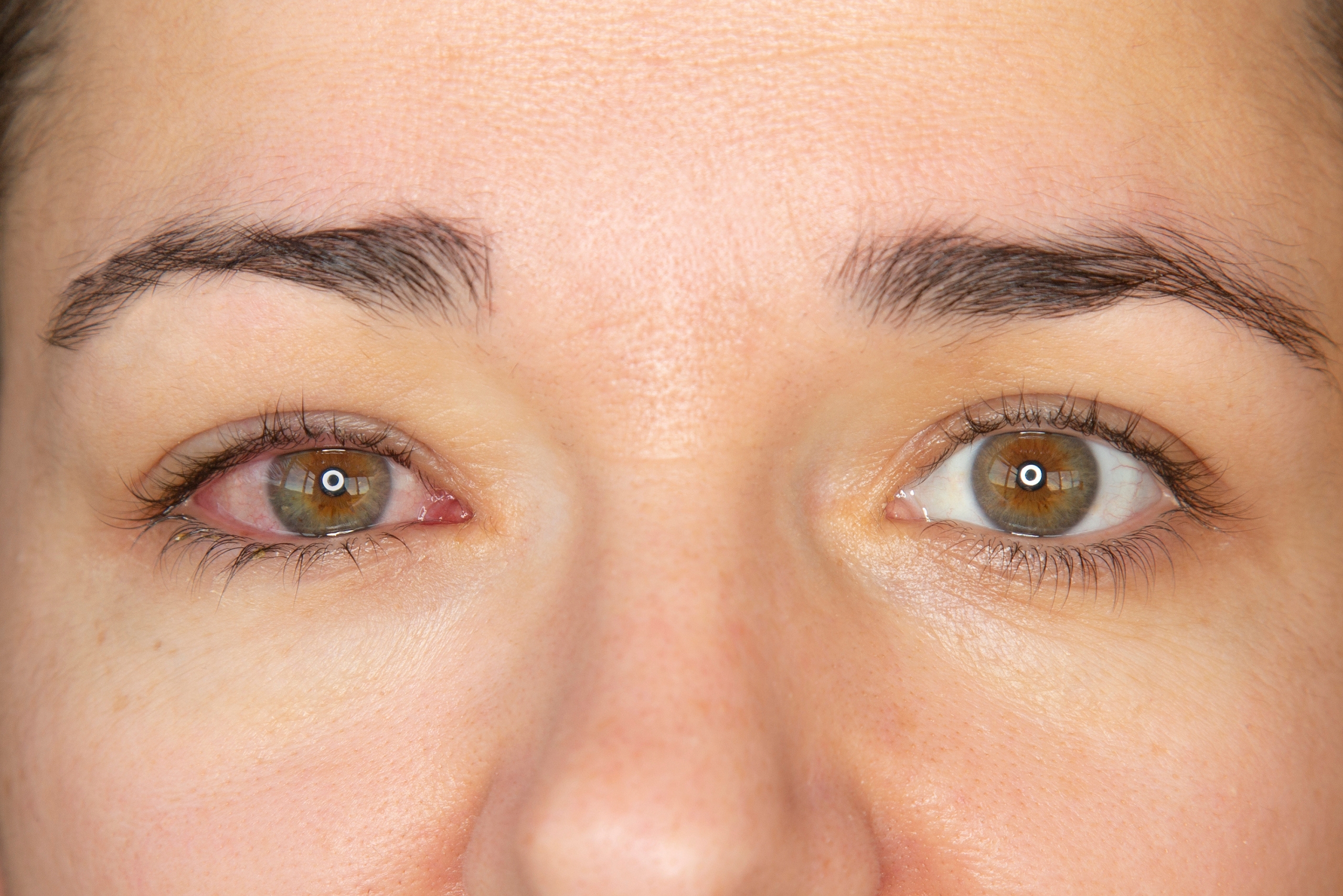Conjunctivitis is one of the most common and treatable eye conditions in children and adults. Often called “pink eye,” it is an inflammation of the conjunctiva, the tissue that lines the inside of the eyelid and the white of the eyeball, and helps keep the eyelid and eyeball moist.
Viruses, bacteria, irritating substances (shampoo, dirt, smoke, pool chlorine), or allergens (substances that cause allergies) can all cause conjunctivitis. Pink eye caused by bacteria or viruses can spread easily from person to person, but it is not a serious health risk if diagnosed promptly; allergic conjunctivitis is not contagious.
It is important to find out whether your pink eye is caused by allergies or infection because each condition has different treatments. This article focuses on allergic conjunctivitis.

What Are the Symptoms of Allergic Pink Eye?
Symptoms of allergic pink eye include:
- Redness in the white of the eye or inner eyelid
- Increased amount of tears
- Itchy eyes and nose
- Blurred vision
- Sneezing
- Swelling of the eyelid
See your ophthalmologist (a doctor and surgeon who is trained to treat eye conditions), optometrist (doctor trained to treat eye conditions), or family doctor if you have any of these persistent symptoms.
How Is Allergic Pink Eye Treated?
Allergy-associated pink eye may disappear completely, either when the allergy is treated with antihistamines, or when the allergen is removed. So, the first line of treatment is allergen removal. This may include things like wearing a hat outside and washing your face frequently during allergy season. Your doctor also may recommend you use one or more of the following:
- Ocular (topical) decongestants: These medicines reduce redness by constricting small blood vessels in the eye. They are not recommended for long-term use. Using these drops for more than a few days can actually worsen symptoms.
- Ocular (topical) antihistamines: These medicines reduce redness, swelling, and itching by blocking the actions of histamine, the chemical that causes these symptoms of allergy. They are available both over-the-counter and by prescription.
- Ocular (topical) lubricants: People with allergic conjunctivitis often don’t produce enough tears which make symptoms worse. Lubricant drops can be used hourly if needed.
- Ocular (topical) steroids: When other medicines fail, your doctor may prescribe steroid eye drops to relieve the symptoms of conjunctivitis. These must be used with the supervision of your doctor, because they can cause elevated pressure inside of the eye, which can lead to vision damage. Your doctor also must check for viral eye infections, such as herpes, before ocular steroids are used. These drops can also increase the risk of cataracts, clouding of the lens of the eye that can impair vision.
- Ocular (topical) mast cell stabilizers (such as Cromolyn): This medicine works by preventing specialized cells from releasing histamine. It works best when started before symptoms occur.
- Systemic (oral) versions of the above medications: These are used for severe cases.
- Immunotherapy: Allergy shots can be effective for treating pink eye caused by allergies. Oral tablets containing the same extracts as shots are also available.
 How Can I Relieve Symptoms of Allergic Pink Eye?
How Can I Relieve Symptoms of Allergic Pink Eye?
To relieve symptoms of allergic pink eye:
- Remove contact lenses, if you wear them.
- Place cold compresses on your eyes.
- Try nonprescription “artificial tears,” a type of eye drop that may help relieve itching and burning (note: Other types of eye drops may irritate the eyes and should not be used). Do not use the same bottle of drops in the other eye if it is not affected.
The best defense against allergic pink eye is a good offense: Try to avoid substances that trigger your allergies. An allergy specialist can test to determine what your specific triggers might be.
When Should I Seek Emergent Care for Pink Eye?
The following groups of people should seek medical care for any symptoms of conjunctivitis:
- Infants (four weeks old or younger)
- Persons who wear contact lenses who have continued symptoms 12-24 hours after removing the contacts
- Persons with weakened immune systems
All other people should seek care when any of the following symptoms are present:
- Eye pain
- Reduced or blurry vision
- Sensitivity to light
- Inability or refusal to open eyelid
- Severe headache or nausea
- Recent trauma to the eye
- Symptoms that get worse or do not improve within 24 hours after starting an antibiotic for suspected bacterial conjunctivitis
Surepoint Emergency Center is a modern emergency medical facility open 24/7. As an alternative to the traditional hospital ER experience, we offer convenience and minimal wait time, along with highly-trained emergency medical staff and state-of-the-art equipment.
Our top priority is bringing high quality emergency care, quickly and easily to your family. We are committed to making patients feel better faster in a comforting and compassionate environment.
Fast, convenient care in your neighborhood.
Article Credit:
 Medically Reviewed by Whitney Seltman, OD on November 06, 2024 Written by WebMD Editorial Contributors
Medically Reviewed by Whitney Seltman, OD on November 06, 2024 Written by WebMD Editorial Contributors
Texas Department of Health & Human Services
https://my.clevelandclinic.org/health/diseases/allergic-conjunctivitis



